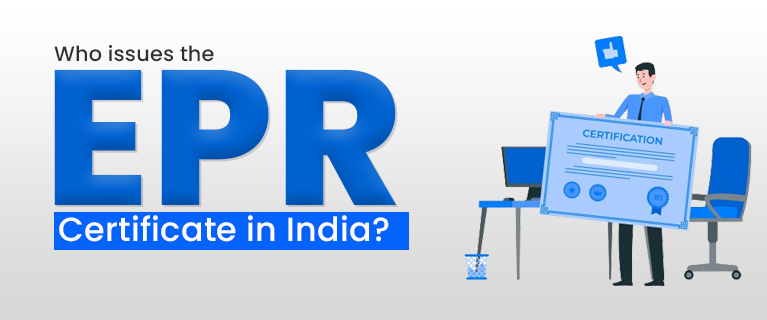EPR Registration in Achieving a Sustainable Product Lifecycle
In the dynamic landscape of modern business, the concept of sustainability has become paramount. Companies worldwide are recognizing the need to shift towards environmentally responsible practices, not only for compliance but also as a strategic imperative for long-term success. One crucial aspect of this shift is the implementation of Extended Producer Responsibility (EPR) and its profound impact on achieving a sustainable product lifecycle.
Understanding EPR Registration:
Extended Producer Responsibility is a policy approach that extends the producer's responsibility for a product throughout its lifecycle, including post-consumer disposal. EPR encourages manufacturers to minimize the environmental impact of their products by taking responsibility for their entire lifecycle. This includes collection, recycling, and proper disposal, ensuring that products do not end up as pollutants in landfills or oceans.
Key Components of EPR Registration:
1. Product Design: EPR Certification encourages companies to design products with the end in mind, considering recyclability, reusability, and the use of eco-friendly materials.
2. Waste Collection Systems: Manufacturers are required to set up or contribute to effective waste collection systems, making it easier for consumers to responsibly dispose of their products.
3. Recycling Infrastructure: EPR Certification involves investing in and supporting recycling facilities to ensure that collected materials are efficiently processed and reintegrated into the production cycle.
4. Financial Responsibility: Producers bear the financial responsibility for the collection and recycling of their products, creating a direct incentive to reduce environmental impact.
Read Also This – How To Get EPR Certification or License in India
Sustainable Product Lifecycle:
EPR registration is a catalyst for transforming the traditional linear product lifecycle into a sustainable, circular one.
1. Resource Efficiency:
EPR registration serves as a pivotal driver for enhancing resource efficiency throughout the product lifecycle. Companies committed to EPR principles actively seek eco-friendly materials and employ innovative design strategies to ensure products are not only functional but also optimized for minimal environmental impact.
Eco-Friendly Material Selection: EPR Certification encourages companies to choose materials with lower environmental footprints. This could involve selecting recycled materials, responsibly sourced resources, or materials with a reduced ecological impact. The emphasis is on minimizing the environmental consequences associated with the extraction and processing of raw materials.
Design for Disassembly: Products designed under EPR guidelines often prioritize ease of disassembly. This design approach facilitates the separation of different components, making it simpler to recycle or repurpose individual parts. It not only supports recycling initiatives but also contributes to the efficient utilization of resources by allowing the reuse of components.
Closed-Loop Systems: Companies embracing EPR Certification explore closed-loop systems where materials from discarded products are reintegrated into the manufacturing process. This closed-loop approach minimizes the demand for virgin resources, fostering resource conservation and reducing the overall environmental impact of production.
2. Reduced Environmental Footprint:
EPR Certification initiatives inherently lead to the development of products with a substantially reduced environmental footprint. This encompasses a broad spectrum of environmental considerations, including greenhouse gas emissions, pollution, and energy consumption.
Greenhouse Gas Emissions: Sustainable practices encouraged by EPR Certification, such as the use of renewable energy sources and eco-friendly materials, contribute to the reduction of greenhouse gas emissions. This is crucial for mitigating climate change and promoting a more sustainable approach to product manufacturing.
Pollution Prevention: EPR emphasizes responsible disposal practices and the reduction of harmful substances in products. By avoiding or minimizing the use of pollutants in manufacturing, companies contribute to reducing water, air, and soil pollution, thereby fostering a cleaner and healthier environment.
Energy Conservation: The adoption of energy-efficient processes and the incorporation of renewable energy sources are common components of EPR-compliant practices. This not only aligns with sustainable energy goals but also results in a decreased overall energy footprint associated with product life cycles.
3. Circular Economy:
One of the fundamental transformations catalyzed by EPR registration is the transition from a linear product lifecycle to a circular economy. This shift involves designing products with a focus on reuse, remanufacturing, and recycling, thereby minimizing waste and extending the lifespan of materials.
Product Reuse: EPR encourages companies to design products that can be easily refurbished and reused. This may involve creating modular components, enabling consumers to upgrade or repair products instead of discarding them. Reuse is a critical aspect of the circular economy, as it extends the life of products and reduces the demand for new manufacturing.
Remanufacturing: EPR Certification supports remanufacturing practices, where products are disassembled, refurbished, and restored to a like-new condition. This approach not only extends the product lifespan but also reduces the environmental impact associated with creating entirely new products.
Recycling Initiatives: EPR Certification promotes robust recycling programs for end-of-life products. Companies develop strategies to ensure that materials are efficiently recycled, diverting them from landfills. The integration of recycled materials back into the manufacturing process completes the circular loop, minimizing the need for virgin resources.
4. Consumer Awareness:
Beyond the operational aspects, EPR Certification involves engaging consumers in the sustainable product lifecycle. Educational campaigns and awareness initiatives are integral components, fostering a culture of responsible consumption and disposal.
Educational Campaigns: Companies investing in EPR Certification often conduct educational campaigns to inform consumers about the environmental impact of their products and the importance of responsible disposal. This awareness helps consumers make informed choices and actively participate in sustainable practices.
Labelling and Communication: EPR-compliant products may feature labels or communication materials that convey information about the product's environmental attributes and proper disposal methods. This transparency empowers consumers to align their purchasing decisions with sustainability goals.
Behavioral Shift: EPR contributes to a broader shift in consumer behavior, encouraging a mindset of environmental responsibility. As consumers become more conscious of the impact of their choices, they are likely to support companies that prioritize sustainability, driving market demand for eco-friendly products and practices.
In summary, EPR registration acts as a catalyst for transforming the product lifecycle into a sustainable, circular model. From resource efficiency and reduced environmental footprints to the promotion of a circular economy and heightened consumer awareness, EPR initiatives reshape the way companies approach product design, manufacturing, and end-of-life management, contributing to a more sustainable and responsible future.
Read Also This – How To Get EPR Certificate For Your E waste Management
Business Benefits of EPR Registration:
1. Brand Reputation:
Embracing Extended Producer Responsibility (EPR) and obtaining registration under its framework significantly contributes to a company's brand reputation. In today's environmentally conscious consumer landscape, customers are increasingly aware of the environmental impact of the products they purchase. Companies that proactively engage in sustainable practices, such as those mandated by EPR Certification, are viewed favorably by consumers.
Consumer Trust and Loyalty: EPR signifies a commitment to environmental stewardship, earning the trust and loyalty of environmentally conscious consumers. When consumers identify a brand as environmentally responsible, they are more likely to choose its products over competitors that may not share the same commitment.
Transparency and Accountability: EPR registration necessitates transparency in reporting and accountability for the environmental impact of a company's products throughout their lifecycle. This openness builds a positive perception among consumers who increasingly demand transparency from the brands they support.
Market Differentiation: EPR registration sets a company apart in the market. It becomes a distinctive feature that can be highlighted in marketing and branding efforts, attracting a niche market segment that prioritizes sustainability. This differentiation is crucial in a competitive business landscape.
2. Regulatory Compliance:
EPR registration ensures that companies comply with environmental regulations related to the management and disposal of their products. Governments globally are implementing stricter environmental laws, and adherence to these regulations is imperative for businesses to avoid legal risks and penalties.
Legal Safeguard: By registering for EPR Certification, a company aligns itself with legal requirements related to product stewardship and end-of-life management. This shields the company from potential legal consequences, fines, and other punitive measures that may arise from non-compliance.
International Standards: EPR Certification often aligns with international environmental standards, providing companies with a standardized framework for compliance. This can be particularly advantageous for businesses engaged in global trade, ensuring consistency in their environmental practices across different regions.
Adaptability to Evolving Regulations: EPR frameworks are designed to evolve with changing environmental regulations. Companies that register under EPR demonstrate a commitment to adapting their practices to meet emerging environmental standards, showcasing flexibility and foresight.
3. Cost Savings:
While some companies might perceive the adoption of EPR Certification practices as an additional financial burden, in the long run, it often leads to substantial cost savings. EPR encourages businesses to optimize resource use, reduce waste generation, and explore more sustainable alternatives.
Resource Efficiency: EPR drives companies to assess and enhance their resource efficiency. This includes optimizing manufacturing processes, reducing raw material usage, and implementing recycling initiatives. These efficiency gains often result in direct cost savings through reduced resource consumption.
Waste Disposal Reduction: Proper management of product end-of-life, a key component of EPR Certification, can lead to significant reductions in waste disposal costs. Recycling and responsible disposal practices minimize the financial impact associated with waste management and disposal fees
Operational Streamlining: EPR Certification encourages companies to streamline their operations for environmental efficiency. This process often identifies areas of redundancy and inefficiency, leading to operational improvements that contribute to overall cost savings.
4. Innovation and Competitive Advantage:
EPR Certification fosters a culture of innovation within companies, pushing them to explore new ways of designing products and managing resources sustainably. This innovation not only aligns with environmental goals but also provides a competitive advantage in the market.
Product Design Innovation: EPR challenges companies to rethink their product designs with a focus on sustainability. This may involve using eco-friendly materials, designing products for easier recycling, or creating durable goods with extended lifespans. Such innovative product design can attract environmentally conscious consumers
Manufacturing Process Improvements: To meet EPR Certification requirements, companies often need to reevaluate their manufacturing processes. This can lead to the adoption of cleaner and more efficient production methods, enhancing overall operational efficiency and reducing environmental impact.
Market Recognition: Companies that embrace EPR and incorporate sustainable practices gain recognition in the market. This recognition not only attracts environmentally conscious consumers but also positions the company as a forward-thinking industry leader, further enhancing its competitive advantage.
Read Also This – Is It Obligatory To Seek EPR Certification In India
To sum up, EPR registration brings about a multitude of business benefits, ranging from enhanced brand reputation and regulatory compliance to tangible cost savings and a competitive edge through innovation. Companies that integrate EPR into their business strategies demonstrate a commitment to environmental responsibility, positioning themselves for long-term success in a market where sustainability is increasingly valued by consumers and regulators alike.
In conclusion, EPR Certification is not just a regulatory requirement; it is a pivotal strategy for businesses aiming to thrive in a world increasingly focused on sustainability. By adopting EPR principles, companies can contribute to building a circular economy, reduce their environmental footprint, and position themselves as leaders in responsible and sustainable business practices. Embracing EPR is not only a responsibility but a pathway to a resilient and sustainable future for both businesses and the planet.










